Dredging Our Eco Inheritance:
New Work by Jason deCaires Taylor
Daniel Levis Keltner
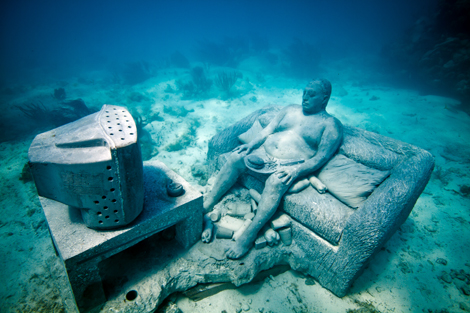
International artist Jason deCaires Taylor recently unveiled a new collection of underwater sculptures at the Museo Subacuático de Arte (MUSA) titled “Que Hemos Hecho (What Have We Done).” In Taylor’s own words, these sculptures aim to “explore the significant impact humans have had on our planet’s ecosystems and the subsequent effect to future generations.”
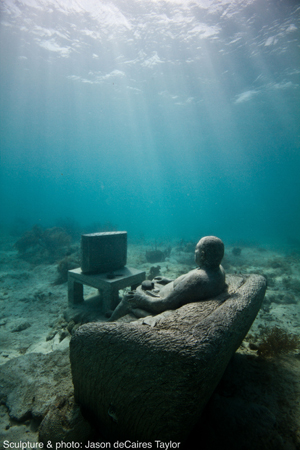
Taylor is the founder and Artistic Director of MUSA in Cancun, Mexico, where he has showcased his most renowned works, such as “La Evolución Silenciosa,” an ambitious project composed of 400 life-size figures modeled after real people from Mexico and throughout the world.
As an environmental artist, Taylor’s underwater sculptures serve as both art and eco-activism. His most recent collection, “Que Hemos Hecho,” continues in that vein. The three initial pieces, “Inercia,” “Vacio,” and “Hernacia,” (respectively translated to “Inertia,” “Void,” and “Inheritance”) are sited within shallow waters of The National Marine Park, located in the northern part of the Mexican state of Quintana Roo, areas severely damaged by hurricanes and tropical storms, where the ecosystem is in need of regeneration. These sculptures are, in a utilitarian sense, artificial reefs for both plant and animal marine life to colonize and inhabit. Additionally, Taylor’s sculptures are made with environmental-friendly materials—pH-neutral concrete reinforced with special inert fiberglass rebar.
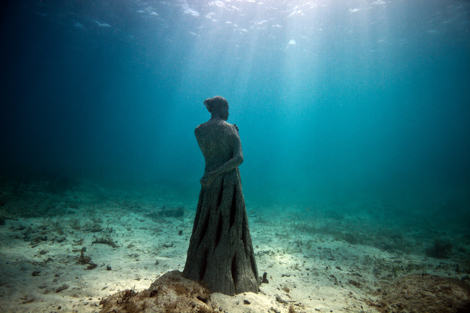
Of his work, Taylor says, “I am trying to portray how human intervention or interaction with nature can be positive and sustainable, an icon of how we can live in a symbiotic relationship with nature.” To facilitate this effect, visitors view his works by diving among the sculptures and marine life, snorkeling, or riding in glass-bottom boats so that they may witness the representational beauty of Taylor’s sculptures, as well as an act of ecological regeneration in progress. In aiming for audiences to reconsider their relationship with the environment and be inspired toward both critical awareness and care, Taylor has put himself on the map among major contemporary environmental artists, such as Betty Beaumont.
Taylor situated his Museo Subaquático de Arte in the waters surrounding Cancun, Mexico, with the intent of fostering environmental stewardship in the largely commercial town. As Artistic Director of MUSA, he aims to usher in a new era for Cancun, one of culture and environmental awareness, in hope that the millions of tourists may begin to reconceptualize the beaches they haunt as more than sunny slices of heaven but living and breathing ecosystems.
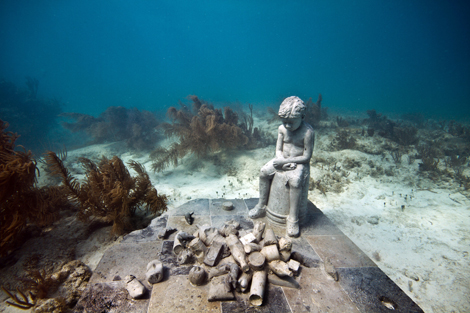
Taylor’s newest collection, “Que Hemos Hecho,” works uncompromisingly to that aim. This collection is arguably Taylor’s most foreboding work to date. With despondent poses and ominous titles, the three solitary figures—“Inercia,” “Vacio,” and “Herencia”—are missing the optimism that characterizes much of Taylor’s previous work. Earlier sculptures such as “Vicissitudes,” “La Jardinera de la Esperanza,” “El Colecionista de Los Sueños” and others embody the spirit of inspiration with roots in collective action. However, the figures represented in “Inercia,” “Vacio,” and “Herencia” seem to suffer, perhaps because of their isolation and lack of connection to other figures.
By challenging his own aesthetic, Taylor’s evolution as an artist is evident. When considered as pieces of a single artistic statement, the figures of “Que Hemos Hecho” form a troubled nuclear family, independently bearing a condition in the way of achieving sustainability. Instead of stirring others through hope alone, these pieces allow viewers to more directly confront the origins of ecological trouble, as Taylor frames them, and makes achieving sustainability both an ecological and a moral imperative. As Taylor says of our particular time in history, “I feel we live in such critical times; and, in the thousands of years of human existence, our current generation now has the responsibility to make irreversible decisions with consequences that our children will have to live with forever.”
“Inercia” appears seated somewhat comfortably with so many back pillows, but the elaborate interior environment has become his prison. The proximity of the television set and fast-food dinner in his lap pin him. Posed with his hands on his knees, “Inercia” captures the stolid obliviousness that apathy engenders and the daily frustration of perceived powerlessness. “Vacio” appears withdrawn yet stands at attention. At the same time that she covers herself, “Vacio” holds one arm behind her back, exhibiting both fear and fearlessness, or perhaps surrender, having not completely relinquished herself to non-existence as she gazes out at the blue water that she’ll become a part of in time. The child, “Herencia,” appears tired, exhausted by a great burden as he considers the heap of trash at his feet. His expression tells that he is also in a liminal space, wavering between giving up or starting at the arduous task of cleaning the mess handed down to him. The sculpture of the boy was also a part of “La Evolución Silenciosa,” used twice because, in the artist’s own words, “I was particularly fond of the cast, and his expression of despair really suited the new piece. He is a 3-year-old boy called Santiago and was the youngest person I have ever cast. So brave.”
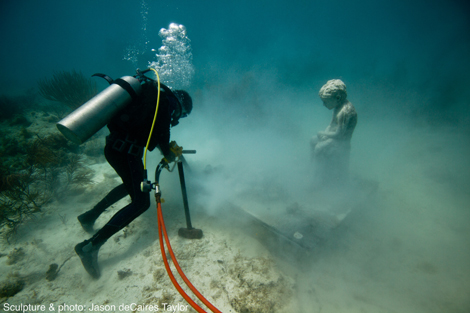
Even when serving his audience artful, cautionary tales, Taylor’s work resists defeatism by providing an example of generative human intervention in the ecosystem. His strategy of conserving reefs against the “land as commodity” mentality of capitalism by tapping into tourism revenue also shows how activists might be able to use the system’s rapacious tendency against itself.
In a recent Orion article, Derrick Jensen railed against people without the backbone to stand strong against environmental apathy, arguing that “If our actions make … even a one-thousandth of 1 percent chance that things will work out better for ourselves and the planet, then it is our moral duty to act and act and act.” As an artist and activist, Jason deCaires Taylor represents those engaged in the proactive stewardship necessary to maintain moral integrity, if not avert environmental tragedy. His work serves as a living example of the good that can be accomplished by individual imagination, collective effort, and hard work despite our ecological inheritance.

Daniel Levis Keltner, Managing Editor

Your work surprises and pleases me more and more each time I see it. Congratulations.
I wish I were a tunafish, then I could really explore such beauty closer. God bless you and your amazing pieces.
Jason recently completed another piece for the “Que Hemos Hecho” series called “Anthropocene.” To view this newest addition, please visit: http://www.underwatersculpture.com/pages/gallery/latest-works.html
Me encantaron las piezas. Espero que el Museo MUSA tenga mas difusion porque no habia yo oido del el, ni en el Distrito Federal ni en San Diego, CA. felicidades!